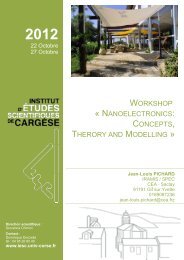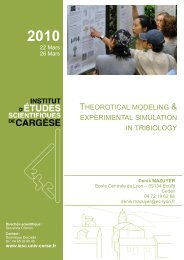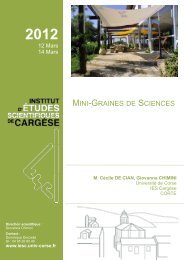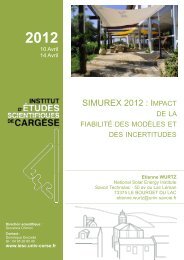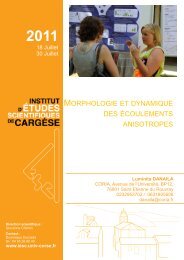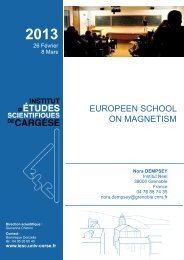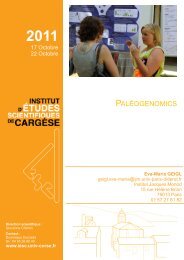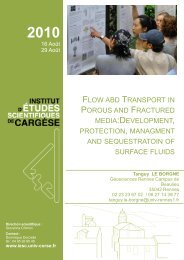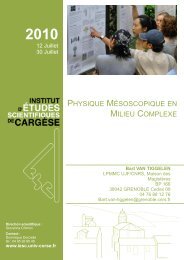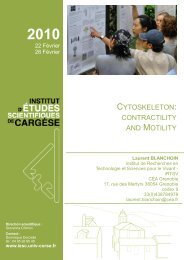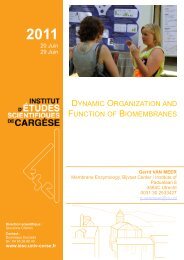Mathias FINK - Institut d'études scientifiques de Cargèse (IESC)
Mathias FINK - Institut d'études scientifiques de Cargèse (IESC)
Mathias FINK - Institut d'études scientifiques de Cargèse (IESC)
Create successful ePaper yourself
Turn your PDF publications into a flip-book with our unique Google optimized e-Paper software.
holes drilled in a rather homogeneous soil.<br />
Pr. Vincent Lau<strong>de</strong><br />
Phononic crystals for the control of acoustic waves<br />
Phononics can be <strong>de</strong>fined as the science of <strong>de</strong>signing artificial acoustic materials with tailored<br />
dispersion properties. Of special interest are phononic crystals, two- or three-dimensional<br />
periodically structured materials that show a number of amazing properties - but only if properly<br />
<strong>de</strong>signed. For instance, strong confinement of wave energy can be obtained insi<strong>de</strong> complete band<br />
gaps, i.e., frequency ranges within which no wave propagation is allowed, whatever the inci<strong>de</strong>nce<br />
and the polarization. Even outsi<strong>de</strong> band gaps, the periodic structure leads to very strong spatial<br />
dispersion, resulting in properties unavailable with usual homogeneous materials. I will highlight<br />
recent achievements in the field of phononics and use them to emphasize that much remains to be<br />
achieved. Topics inclu<strong>de</strong> experimental <strong>de</strong>monstrations of band gaps, waveguiding and cavity<br />
<strong>de</strong>sign, crystals for surface acoustic waves, and phononic crystal slabs.<br />
Pr. José Sánchez-Dehesa<br />
Recent Advances on Acoustic Metamaterials<br />
I will start reporting the advances on acoustic cloaking and our experimental <strong>de</strong>monstration of 2D<br />
and 3D acoustic cloaks based on scattering cancellation. Afterwards, I will review the latest results<br />
on acoustic metamaterial with negative parameters and <strong>de</strong>nsity near zero materials. In these topics,<br />
the multiple scattering method has been employed as a tool to <strong>de</strong>sign building units of artificial<br />
structures whose effective parameters can be adjusted. Experiments supporting the theoretical<br />
prediction will be also <strong>de</strong>scribed.<br />
Dr. Sergey Skipetrov<br />
Quantum optical resources for imaging and wave control in random media<br />
Many imaging and adaptive techniques can be realized in very similar ways with different kinds of<br />
waves : light, microwaves, sound or elastic waves, for example. Light has, however, an important<br />
difference as compared to other waves : it exhibits manifest and readily controllable quantum<br />
properties un<strong>de</strong>r standard experimental conditions (room temperature, atmospheric pressure,<br />
visible wavelength). The purpose of this lecture will be to imagine and explore the possible uses of<br />
this new, quantum resource for practical purposes. In particular, we will discuss the use of nonclassical<br />
states of light (Fock and squeezed states) to probe turbid media, as well as the potential of<br />
quantum entanglement between photons to control their propagation through a random<br />
environment.



